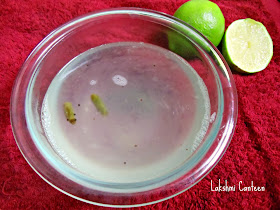Takka Saaru is a very simple and healthy soup. It is a very old Konkani dish. In Konkani taaka means buttermilk. I tried this for the first time. You might not believe it tasted out of the world! Never thought it would turn out this good. Each ingredient added to this saaru has contributed its own flavor and the result is a yummy saaru/soup. This is a very good accompaniment to rice. Try this healthy yet tasty saaru. I am sure this is a treat for the yogurt lovers!
Ingredients:
Ingredients:
- Onion, small- 1
- Garlic pods- 3
- Cilantro/Coriander leaves-1/4 th of a bunch
- Green Chilli- 2-3
- Cumin seeds/Jeera- 3/4 tsp
- Whole Peppercorns- 1/4 tsp
- Yogurt/Curd- 1/2 cup
- Ghee/Clarified butter- 1 tsp
- Salt- To taste
- Water- 1 1/2 cups
You can as well use Buttermilk for this saaru. Then you might have to decrease the amount of water added.
Procedure:
Chop the onion and garlic. Then wash cilantro and give a rough chop to it.
Now heat ghee and then add cumin seeds. After few seconds add chopped onion and garlic. Fry them until they turn translucent. Then add chopped green chillies and whole peppercorns. Continue frying for 1-2 minutes. Then add Chopped cilantro and salt. Fry for a minute or two. Turn off the heat. Allow it to cool. Then grind it to get a paste (don't worry if its not a fine paste).
Now take a bigger dish and then add curd, water and the prepared paste. Mix it well and start heating it on a low flame (yes it has to be heated on a low flame otherwise you end up spoiling the texture of the curd). Stir it continuously. Once the mixture is hot enough, turn off the heat. Takka Saaru is ready!!
Serve it hot with rice. Above measurement serves 2-3 people.


















































